West Seattle, Washington
29 Monday
Thanks to everyone who’s sent enough bird photos that we can bring you this Sunday gallery! Above, Lindsay Gonzalez saw the “brown crow” – technically known as “leucistic” – with one of its more-common-colored counterparts at Westwood Village. (Our fascination with these dates back to the saga of “Leucy,” who died in the 2009 heat wave.) We also received two owl photos – a Barn Owl, which Zutsea says is the first one they’ve seen in 20+ years in West Seattle:
And we’ll confess, this next owl photo wasn’t taken in West Seattle, but it was sent to us by WSB reader Tanya Stambuk, who photographed this Great Horned Owl in Gig Harbor:
(They HAVE been seen here, too.) We don’t have an ID on this bird – a hawk? – photographed by Jon Anderson:
Now a few much-smaller birds – Gene Pavola caught a hummingbird pausing:
Joshua Crowgey sent this pic of a Dark-eyed Junco:
From Jerry Simmons, an Orange-crowned Warbler:
He also sent this Bald Eagle photo:
And we conclude with another bird seen on the shore =- Robin Sinner photographed Sanderlings at Constellation Park:
Once more, HUGE thanks to everyone who’s sent bird photos through the year, as well as wildlife, other scenery, and breaking news too – we really appreciate being able to share your discoveries – westseattleblog@gmail.com is optimal but if/when text works better for you – and when it’s breaking news – we’re at 206-293-6302.
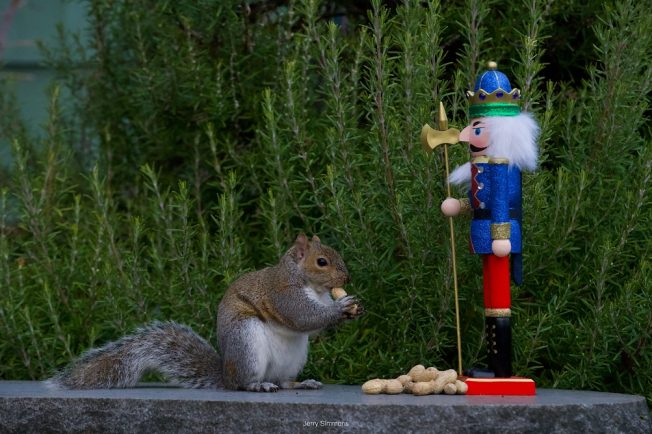 (Photo by Jerry Simmons, who captioned it ‘a couple of nutcrackers’)
(Photo by Jerry Simmons, who captioned it ‘a couple of nutcrackers’)
Want to see somewhat wilder wildlife on Christmas? Assuming the potential windstorm treats trees, wildlife, and the rest of us kindly, here’s an invitation we were asked to share with you for tomorrow morning:
4th Annual Christmas Bird / Nature Walk in Lincoln Park (Morning this year)
Get outside Xmas morning at West Seattle’s Lincoln Park for an informal Bird and Nature Walk-ho sted by a volunteer Naturalist.
*No experience necessary; all levels of knowledge are welcome!
*We’ll look for winter birds both on the water and in the forest. We hope to get to see some of these: wild ducks / waterfowl, Juncos, Song sparrows, Chickadees, Robins, Woodpeckers, Corvids, Kinglets, Bald eagle, Cooper hawk, Hummingbirds, Wrens, and more – if we’re lucky.WHERE: Lincoln Park: 8011 Fauntleroy Way SW. Park in the SOUTH Parking Lot (smaller lot closer to the ferry). Look for us at Shelter #3 (down by the water, near the restrooms).
WHEN: 9:30 AM Introduction & Lincoln Park wildlife (time is to take advantage of high tide when water birds are more prolific) .
Bird Walk departs. 9:45 AM – Return to parking lot 11:15-11:30 am.BRING:
*BYOB! – (bring your own Binoculars) Will definitely enhance your experience if you have them or can borrow a pair. We may have an extra. Scope – if anyone has one – please bring it!
*Dry / Warm Clothing Layers (especially on your FEET, head and torso) since it can be quite chilly by the water. Bring gloves. Rain gear for the possible shower or two in the forecast. It WILL be muddy in places.
*Water / snack if you wishNOTES:
*No DOGS please – we love ‘em but wildlife definitely does not
*ROUTE: We will start out along the flat trail by the water for about 30 min and then will walk up the incline into the forest. Most L. Pk trails are about a 5% incline, but the incline into the forest can be steep. You may turn around at the incline and return to parking if you wish. Note: It is also fairly steep from the parking lot down to Shelter #3
*Sometimes they close the RESTROOMS at Lincoln Park. Hoping that’s not the case. But best to prepare a contingency plan should that happen.
*CHILDREN may not enjoy this outing unless they are accustomed to walking slowly and have experience standing quietly for long periods of time.
With one week until Christmas, you might still be shopping for special people on your list. If any of them are nature fans – West Seattle photographer and naturalist Madison Kirkman might have the perfect gift idea: “My partner and I have been working on making a calendar for the Seattle area with all kinds of naturalist information for the area – whale migrations, what can be foraged and when, salmon viewing, heron nesting, low tides, moon phases, etc. This is the first year we are selling it.” You can order the calendar here for $20. Madison has a free online version too – “We don’t want money to be an exclusionary factor for anyone having this information. We just want people to know what exists around us and how/when to see it! So it’s a local resource online and also a calendar if anyone wants to physically see it at a glance.”
Our featured photo atop Friday’s West Seattle event list was that of a California Sea Lion hanging out at Don Armeni Boat Ramp, photographed the previous day by Jan Pendergrass. As we always do when we get a report and/or photo about a marine mammal ashore, we asked if Seal Sitters Marine Mammal Stranding Network had been notified, and she assured us they had. Today, Seal Sitters’ David Hutchinson provides us with more photos and the backstory on what happened:
(Photos by David Hutchinson, Seal Sitters MMSN)
The Seal Sitters Hotline received a call Thursday afternoon concerning a sea lion on one of the docks at the Don Armeni Boat Ramp. A responder was sent to assess the situation and additional volunteers were contacted.
While sea lions commonly do use docks to rest, it’s unusual for them to haul out at this location, so our NOAA network partner SR3 was contacted for assistance with a visual health assessment. SR3 operates a marine mammal hospital in Des Moines, south of Seattle, and Seal Sitters always appreciates their expertise when questions come up about a marine mammal’s condition. The consensus was that this animal, while a bit thin, at this time was just using the dock to rest. Seal Sitters maintained a presence, monitoring its condition.
A few hours later, the first sea lion was joined by a second one. We want to thank the boaters for their cooperation in giving these animals space to rest by launching and retrieving their boats from the other dock. In our urban environment, there are limited areas where marine mammals can safely rest. Both of these animals returned to the waters of Elliott Bay later in the evening.
Seal Sitters had some questions about a possible brand on the first sea lion and some circular marks on the second one. After a study of photographs taken at the site, KC Scofield, SR3’s Response Program Coordinator, determined that they were familiar with the first sea lion on the dock. He was nicknamed “Oscar” by locals in the Des Moines marina, where he resided for some time last winter. He was “treated in the field” for what appeared to be an infected jaw injury. That injury is still visible in Thursday’s photo but no longer appears infected. SR3 provided us with the following links to learn more about Oscar’s story: here and here.
KC also felt that the circular marks on the second sea lion were likely bite marks from a “Cookie Cutter shark.” She mentioned that “Marine mammals are often the favorite snack of these little sharks and while the bites may look bad, they recover quite well from them.”
Seal Sitters and SR3 are members of NOAA’s West Coast Marine Mammal Stranding Network. Seal Sitters covers the West Seattle shoreline from Brace Point through Harbor Island and the Duwamish River. Our Hotline is staffed from 8 AM – 8 PM every day of the week. Please report any marine mammal you come across on the beach, alive or dead, or if you feel that an animal in the water is in distress. You can leave a voice mail if calling during other hours.
The hotline number is 206-905-SEAL – that’s 206-905-7325.
Time for one of our periodic Sunday afternoon bird galleries, thanks to the photographers who’ve sent pics! We start with three from the prolific Jerry Simmons – above, an Anna’s Hummingbird; below, Canada Geese, and a quizzical Bushtit:
Tom Trulin photographed this Mallard at Cove Park in Fauntleroy:
Steve Bender found this Heron in South Park:
Julia Schroeder photographed this Bald Eagle outside her home:
And Mark Carroll sent this sighting from North Shorewood:
Between galleries, we also publish bird photos with our daily lists on occasion, along with other types of West Seattle photos – thanks again to everyone who shares theirs, so we can in turn share with you – westseattleblog@gmail.com any time!
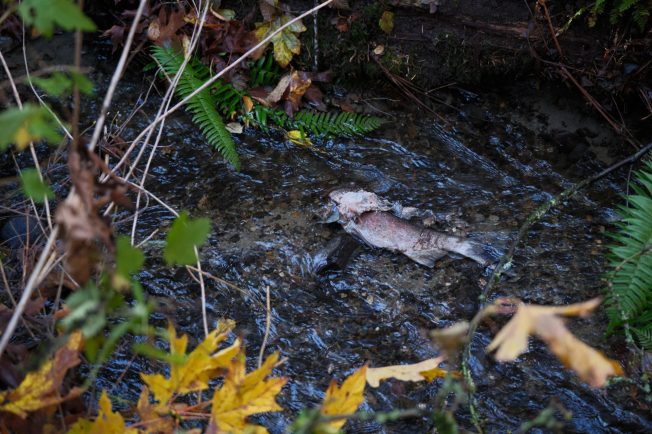 (This photo and next by Dave Gershgorn. Above, spawning pair that chose a spot just above the fish ladder)
(This photo and next by Dave Gershgorn. Above, spawning pair that chose a spot just above the fish ladder)
By Judy Pickens
Special to West Seattle Blog
With great enthusiasm, 130 people kicked off Salmon Watch 2025 on Fauntleroy Creek with the Fauntleroy Watershed Council’s annual drumming to call in coho spawners. Dozens of vigorous fish had been sighted schooling in Fauntleroy Cove, and nearly three dozen volunteers made sure their route along the beach stayed open.
Watchers checked the spawning reach daily, school groups came on field trips, and 100 members of the general public came to the council’s “open creek” in the spawning reach on November 9. Everyone’s reward was slim, however. From October 26 through November 21, watchers documented only nine fish and one spawning pair.
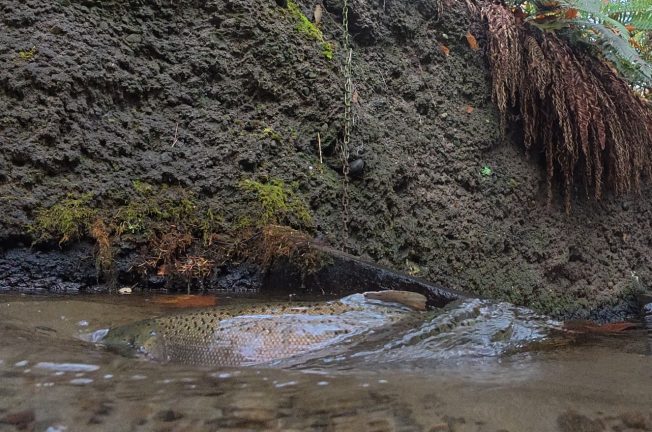 (Full of eggs, the last spawner pushed ahead through the fish ladder November 10 without a mate)
(Full of eggs, the last spawner pushed ahead through the fish ladder November 10 without a mate)
While disappointing, such a low count is not unusual for small Seattle creeks. Since Fauntleroy Creek’s first documented pair, in 1994, the count has fluctuated between zero and last year’s record 347.
“These fish need high tides and ample rainfall to flush impurities out of the creek and give them easy entry at the mouth,” said veteran watcher Dennis Hinton. “This year, those conditions did not align, and predation in the cove were especially heavy.”
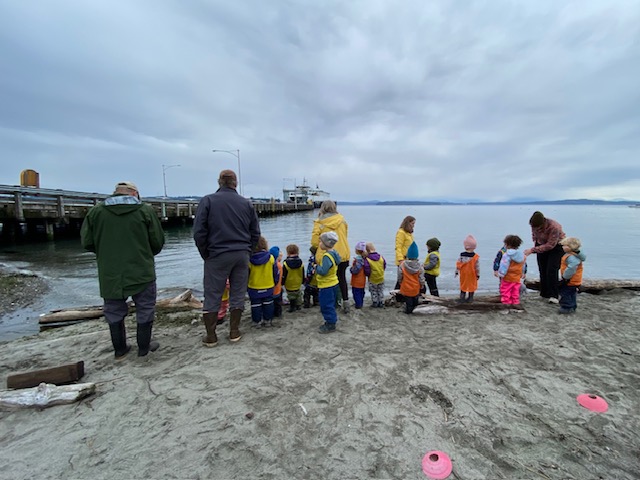 (Photo by Tom Trulin: Volunteers hosted students of all ages, including this group from the Urban Nature Preschool)
(Photo by Tom Trulin: Volunteers hosted students of all ages, including this group from the Urban Nature Preschool)
Volunteers will check the lower creek in February for home-hatch fry, then turn their attention to school releases in the spring. Next year, releases will happen in Longfellow Creek because of the culvert-replacement project. In order to replace the creek culvert under 45th Ave. SW, the contractor will need to dewater the site by pumping creek flow into a bypass pipe, which fish heading to saltwater from the upper creek would not survive.
By Hayden Yu Andersen
Reporting for West Seattle Blog
Last weekend, we reported on the annual Longfellow Creek cleanup event, hosted by Puget Soundkeeper Alliance and Delridge Neighborhoods Development Association. Each year, teams gather to clean up the park and chat with Puget Soundkeeper’s salmon-survey team.
In the wake of the event, Puget Soundkeeper shared their mid-survey data with us. Of note is the fact that this is their first year performing necropsies on both female and male salmon. So far this year, the team has counted 402 live salmon and 125 dead salmon in Longfellow Creek, for a total recorded population of 529. See the data for this year and last year here.
For the past several years, in addition to tracking the coho population, they’ve been monitoring for Urban Runoff Mortality Syndrome (URMS), a condition caused primarily by chemical runoff from car tires. So far this season, the team has recorded 13 live coho with URMS.
When it works its way into a coho population, URMS can be devastating to population numbers. A key element of Puget Soundkeeper’s work has been both tracking and combating the use of 6PPD-Q, the chemical responsible for URMS.
“Unfortunately, the chemical 6PPD-Q has been standard in tire construction for years and is an essential safety mechanism,” said Ewan Henderson, a Clean Water Program Specialist with Puget Soundkeeper. “This means it’s in every tire on the road and can’t really be banned until a viable alternative is on the market.”
But, according to Henderson, last week saw a significant reason for hope. In the past seven days, Wales-based company Perpetuus Advanced Materials and Ohio-based company Flexsys have both announced alternatives to 6PPD-Q, both of which may lead to a reduced environmental impact. However, Henderson pointed out, there are still no policy changes stemming from these developments.
For now, Henderson says the “main focus is on filtering polluted storm water before entering streams,” including using green infrastructure, which has proved effective at reducing the levels of 6PPD-Q in waterways. Here’s a video Henderson recommended from King County Natural Resources and Parks, which explains how green infrastructure works.
In the meantime, if you’re interested in volunteering or donating, or learning more about Puget Soundkeeper Alliance, you can go here.
1 PM: Until 3 pm today, you’re invited to go to upper Fauntleroy Way and SW Director [map] – near the public overlook – and volunteers will invite you down to the banks of Fauntleroy Creek, to see if any coho spawners are in view. We have a team member there and will update as soon as we hear from him!
1:14 PM: WSB’s Torin Record-Sand reports that so far today, salmon watchers have seen two carcasses, no live fish.
Longtime creek volunteer Dennis Hinton says the two were pulled out by a raccoon – but they had spawned before that,
So far, the count this year of coho making it to the spawning area is eight, but they’ve seen about 200 near the creek mouth not far from the ferry dock, where hungry seals have had a heyday, so, of these two and the six others seen: “They’ve made it through a lot of predators to get up here.”
1:55 PM: As of about 15 minutes ago, creek volunteers have counted 54 visitors today.
Many families with little kids, and even though no live fish have shown up yet today, the carcasses have inspired many questions!
2:56 PM: Shoutout to volunteer Elena for the salmon cookies:
Visitors are receiving information on how to volunteer and donate to support the Fauntleroy Watershed Council‘s work supporting and advocating for the creek and its wildlife – all that info is linked here.
MONDAY UPDATE: Creek steward Judy Pickens tells us they counted 100 visitors in all during the two-hour window. And today, two more coho made it into the creek – after somehow surviving a gauntlet of predators, mostly harbor seals, but even a river otter joining the buffet line.
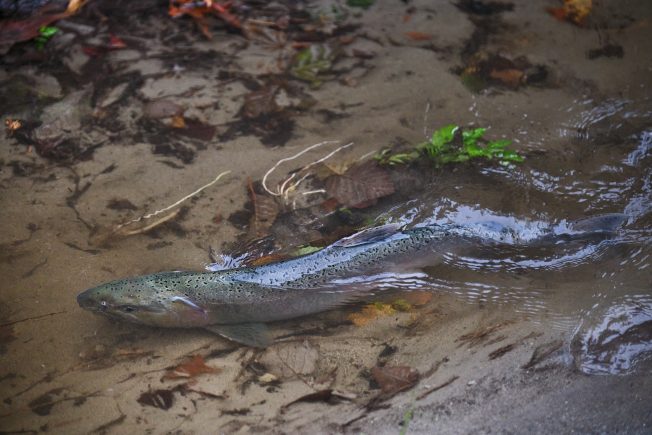 (Monday photo by Dave Gershgorn)
(Monday photo by Dave Gershgorn)
That’s one of the coho salmon seen by volunteers earlier this week near the mouth of Fauntleroy Creek. We don’t know the fate of that particular one – hungry seals have been hanging out there too – but Judy Pickens from the Fauntleroy Watershed Council tells WSB tonight that salmon watchers have seen “eight coho spawners make landfall so far,” so they’re going to welcome visitors this Sunday:
Given the forecast of dry and mild weather, we’ve decided to host our open creek this coming Sunday (11/9) from 1:00 to 3:00 pm. Salmon watchers will be on duty to talk with visitors and, we hope, give them a view of live fish. People should come to the fish-ladder viewpoint at SW Director and upper Fauntleroy Way SW to catch the eye of a watcher, who will invite them down to creek level. Children aged 15 and younger should come with an adult, and dogs should be on leash.
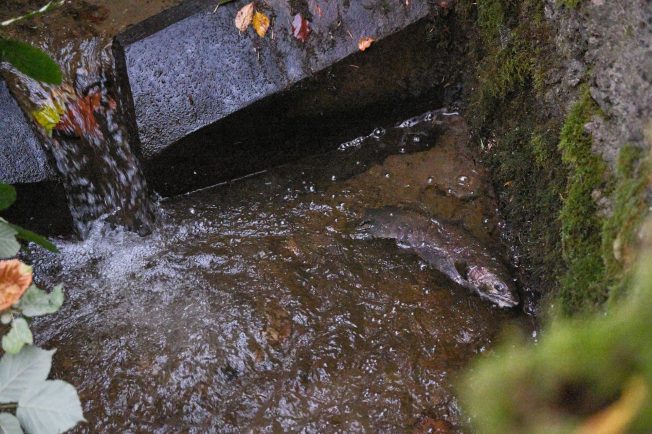 (Fauntleroy Creek photo by Dave Gershgorn)
(Fauntleroy Creek photo by Dave Gershgorn)
While we await election results, here’s a small but very important count: One! Coho-salmon spawners have been seen off the mouth of Fauntleroy Creek off and on for more than a week, and today, Judy Pickens of the Fauntleroy Watershed Council tells us, this one made it to the spawning reach. That meant it was visible from the public overlook across Fauntleroy Way (and upslope) from the ferry dock, but don’t go looking for a closer view – volunteers will figure out the right time for a potential “open creek” window when you’ll have a chance for an up-close look.
By Torin Record-Sand
Reporting for West Seattle Blog
With marine life facing increasing challenges to survive and thrive, you might wonder, who’s the next generation of people studying to help them?
Answer: People like Lola Taylor, a third-year student at Washington State University’s College of Veterinary Medicine, with an interest in marine animals. She’s a 5th-generation Seattleite who grew up here in West Seattle and graduated from Chief Sealth International High School. She is currently president of the WSU College of Veterinary Medicine Aquatics Club, which specializes in bringing speakers on the topic of veterinary work for marine animals, as well as offering lab work opportunities for students in the field.
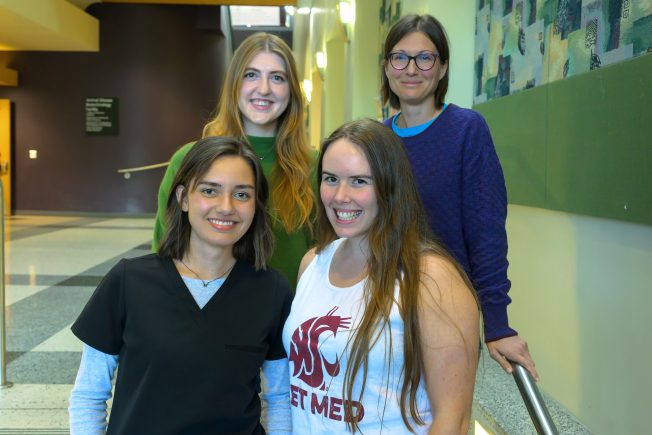 (Officers of Aquatics Club at WSU’s College of Veterinary Medicine, from left, Isabelle Hughes, VP; Katelin Buckley, treasurer; Lola Taylor, president; Katie McDonald, secretary. Photo: Ted S. Warren)
(Officers of Aquatics Club at WSU’s College of Veterinary Medicine, from left, Isabelle Hughes, VP; Katelin Buckley, treasurer; Lola Taylor, president; Katie McDonald, secretary. Photo: Ted S. Warren)
Taylor views her work as a crucial element of the dynamic we have with local marine life. “Humans are the reason marine animals end up in rehabilitation centers, and if humans are causing the issue, they have a responsibility to resolve the issue.” she said.
Her passion started here in West Seattle, on the shores of Puget Sound. As a child, she often visited her grandparents in The Arroyos. She was in second grade when she started taking her visits seriously as a way to engage with local aquatic life. “When I went to the beach, my mom said, ‘If you want to be a scientist, they record the things they observe, so you should take a notebook with you’.”
She started noting as much as she could about the local sea-star population (only now recovering from catastrophic losses): “I’d write down colors of starfish, how many there were, if they were dead or alive, and if one was drying out in the sun at low tide, I’d take it back to the water.” All of this, she said, gave her a solid foundation and appreciation for how deeply connected we are to the life on our shores. “My parents instilled in me respect for animals and the environment from a young age, and it’s shaped the course of my volunteering and career path.” she said.
She has continued to work locally, helping animals both on and off shore. During high school, she volunteered with the Seattle Aquarium‘s “Youth Ocean Advocates” program for three years, contributing more than 400 hours of her time. Her relationship with the aquarium has continued, as she’s recently had opportunities to shadow the veterinary work there and continue to build connections. She’s also helped with the Seal Sitters Marine Mammal Stranding Network here in West Seattle. She remembered fondly volunteering at the Alki Art Fair this summer with the group, doing education work while tabling: “I signed up for a 2-hour shift and kept talking the entire time, I hadn’t even realized two hours had passed – one of my fellow volunteers said ‘are you sure you want to go back to school after this?’”
Her dream is to be able to further this work after graduating from veterinary school. She said that while the field of aquatic veterinarians is very competitive, with limited spots, she is dedicated to the cause no matter what path she might follow. “Even if I don’t end up in the dream of working 40 hours a week at an aquarium, I hope to be able to give back volunteering.” she said.
Currently, her club is raising funds for a trip to the University of Washington‘s Friday Harbor Laboratories, in the San Juan Islands. The trip will allow them to tour the laboratories, as well as participate briefly in some of the work there, and see both local Salish Sea marine species and ways they help treat them. They’re fundraising mainly to provide transportation and housing for the trip, as they’re hoping to accommodate the whole of the club – around 30 students.
She’s hoping to share her passion for Pacific Northwest marine life with her fellow students who are from elsewhere. “A lot of students in our club are students from the East Coast or [other land-locked states] who have only really seen Pullman, this is a great opportunity for them to see the Salish Sea.” she said.
If you want to donate to help her club’s cause for further education about local marine wildlife, and help inspire a future generation of doctors and scientists who could help our local marine life, you can find their page here. The campaign runs only until November 12th, and she says time is of the essence so they can make the trip.
More salmon sightings in Longfellow Creek! Thanks to Manuel Valdes for the photos above and below:
Steve Pumphrey reports sightings too – “6 or 7 good-sized fish” – and sent this photo of a Great Blue Heron pondering some fishing on the creek:
The footbridge south of West Seattle Health Club (28th SW and SWYancy) is a popular viewing spot.
P.S. At Fauntleroy Creek, salmon-watch volunteers are still awaiting the first arrivals, hampered somewhat by downed trees that city crews need to clear.
Thanks to Gary Jones for the photos. Several readers asked today about the presence of multiple boats fishing with nets off Alki Point.
They’re purse seiners that show up about this time many years (here’s one of our past reports), fishing for chum salmon.
If you’re interested in the rules, maps, etc., here’s the 56-page document (which we also linked when purse seiners showed up briefly two months ago).
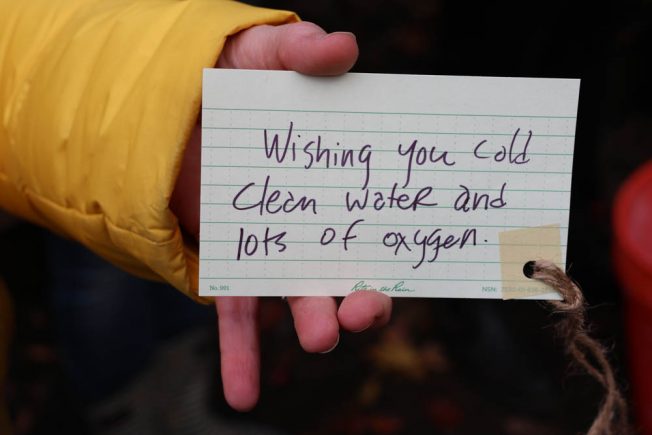 (WSB photos by Torin Record-Sand unless otherwise credited)
(WSB photos by Torin Record-Sand unless otherwise credited)
After all that rain, dozens of salmon spawners are approaching the entrance to Fauntleroy Creek. That’s what longtime salmon-watch volunteer Dennis Hinton told the 100+ people who gathered to ceremonially welcome them home this afternoon: “They’re out there, and they’re coming!”
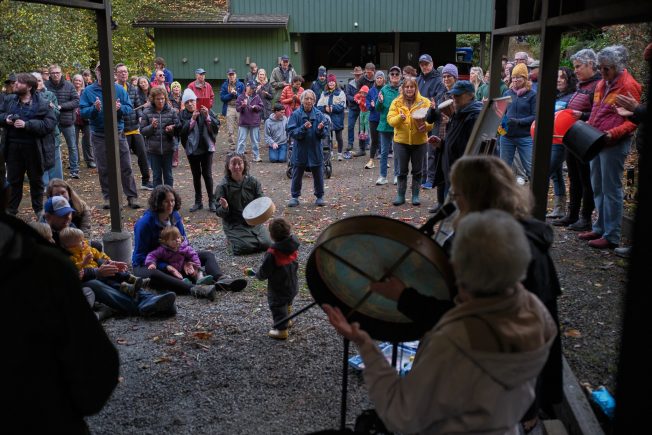 (This photo and next by Dave Gershgorn)
(This photo and next by Dave Gershgorn)
It’s a fall tradition, inviting community members to gather near the creek, to sing and drum during a short gathering that also includes writing messages for the returnees.
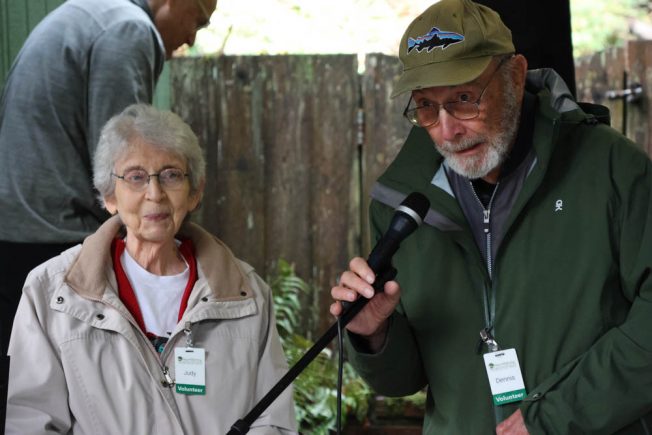 (Judy Pickens and Dennis Hinton)
(Judy Pickens and Dennis Hinton)
The gathering was emceed by Judy Pickens, who – along with husband Phil Sweetland – also has long volunteered for Salmon in the Schools, which will be different for local participants this year as culvert work in Fauntleroy Creek will prevent the release of campus-raised fry, which Judy says will be taken instead to West Seattle’s other major salmon-bearing stream, Longfellow Creek.
But the springtime releases are just part of the circle of life – there’s “home hatch” too, thanks to some of the returnees (347 spawners counted last year). The songs led again this year by Jamie Shilling (above) told the story, as did the drumming – which, as Judy recounted, is meant to mimic the female salmon’s tail slapping the creek bed, making a redd for her eggs.
Participants were discouraged today from going to creekside because – like so many other areas of West Seattle – trees lost limbs last night. But as an afternoon sunbreak peeked through the still-standing trees, a creek-reminiscent blue banner was held over tiny dancers:
Those in attendance ranged from infants to seniors – including 93-year-old volunteer Dick Paynter, honored as the eldermost volunteer in the Watershed Council’s ranks:
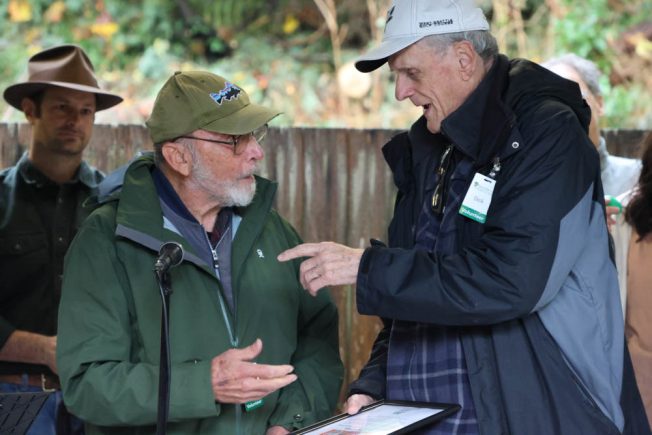 (Dennis Hinton and Dick Paynter)
(Dennis Hinton and Dick Paynter)
Dick declared himself “overwhelmed” by the honor and explained how much the creek work has meant to him, with his interest dating back to his college years as a fisheries major.
And the singing went on, softly: “Hey, hey, coho … return, return, return.”
Once they do start returning, Judy promises updates, as always, and watch for word of a potential “open creek” event if and when weather, safety, and salmon permit.
 (WSB photo, 2023 salmon welcome)
(WSB photo, 2023 salmon welcome)
After watching the forecast for days, Fauntleroy Watershed volunteers have decided to go ahead with what might be an abbreviated – yet spirited as always – community salmon-welcoming gathering on Sunday. From Judy Pickens:
With an atmospheric river poised to flush pollutants out of Fauntleroy Creek this weekend, the annual drumming on Sunday afternoon will sweeten the invitation for spawners to come in from the cove.
Salmon lovers are a hearty bunch, willing to put up with a little or a lot of rain to give our coho a spirited welcome. Those with drums or other instruments can be under cover for what may be an abbreviated program starting at 4 pm Sunday near the fish-ladder viewpoint (SW Director & upper Fauntleroy Way SW). The sound of drumming will draw you down to creek level.
The drumming will kick off Salmon Watch 2025. Two dozen volunteers will be checking the lower creek daily to document the number and condition of the coho that come in (last year they counted a record 347).
I
Earlier this fall, Seattle Parks noted an owl attack in Lincoln Park. We’ve had reader reports of several around the peninsula, Lincoln Park included, over the years. But we hadn’t heard from anyone directly this year until Kevin‘s report arrived a short time ago:
Our 8 year old daughter was scratched on her head by an owl in Lincoln Park during her cross country run practice. Her grandpa exclaimed “what a hoot!” She’s just fine, though, just a little scary. It seems like it’s happened before, and the internet suggests they’re territorial at dusk. We’re going to follow up with her primary care doctor tomorrow to see if there’s anything weird about owls and diseases.
You can learn more about this owl behavior by checking out this Department of Fish and Wildlife fact sheet, choosing “Preventing Conflicts,” and scrolling down to “Dive-Bombing Owls.” As noted there, these incidents are rare.
It’s salmon season in West Seattle creeks!
LONGFELLOW CREEK: Thanks to Manuel Valdes for sending that video of a Monday sighting: “Saw about a half dozen (Monday) afternoon just south of the health club, already trying to get over the first beaver dams.”
FAUNTLEROY CREEK: No official word of sightings here yet but this Sunday (October 26) is the day you’re invited to join in the annual singing and drumming gathering to welcome the coho. 4 pm, show up where SW Director meets upper Fauntleroy Way, across the street and upslope from the ferry dock. Bring something to drum with if you want, but not required. All ages!
By Torin Record-Sand
Reporting for West Seattle Blog
The organization SR3 most often comes to Alki for the activities embodied in its name – Sealife Response + Rehab + Research.
At Alki Coffee Company on Saturday, the activities were education and outreach.
A group gathered at the coffee shop to listen to Casey Mclean, founder and executive director of SR3, which she launched in 2010 as a response to the lack of a marine mammal rescue group in the Pacific Northwest. She summarized her aim at the beginning of her presentation: “I was shocked there was nowhere for sick and injured marine mammals to go. I said, someone should do something about this, and someone said, ‘YOU should do something about this’.”
Mclean’s presentation went over the core tenets of their organization. She covered the ways in which they respond to marine mammal distress, how they rehabilitate marine mammals, and how they research the conditions of marine mammals in this region. She started with a summation of why the work matters: “All of these animals are apex predators, they speak to the health of our ocean overall. If they are sick, everything below them is going to be sick as well. Ultimately this affects all human life.”
The response efforts, she said, cover three main issues that cause serious distress in marine mammals: emaciation, disease, and direct human interaction (such as gunshots, unnecessary human touch, or interaction with domestic animals such as dogs). Their organization, she said, is ready to respond whenever. “We are ready 365 days a year, 24/7. Times aren’t necessarily convenient. The animals need you most right before dawn, right before it gets dark, and on holidays.”
They have both a dedicated ambulance and a truck ready to respond to incidents.
She said the number of reported incidents has increased since the 1990s. This represents a dual-edged sword: “There are more people who are spotting them, there’s more people who live here and we understand why the animals are important – so that’s positive.” but, she said, “There are also issues with the populations, the populations have grown because there is less hunting, so there are more animals now impacted by humans.”
For the rehabilitation portion of the presentation, she went over the details of the SR3 facility in Des Moines, which has been operating since 2021. She provided some statistics: They receive around 600 calls a year, and currently are actively treating around 188 marine mammals. They actively teach students and volunteers in the marine veterinary field, in addition to their primary staff, they’ve taught around 45 students, and have 225 volunteers, who put in around 10,000 hours of volunteer work a year.
Primarily, they care for the marine mammal species most commonly encountered in the Northwest: Harbor seals and their pups, sea lions, and sea otters. But she highlighted that recent patients have included less-often-seen animals, such as a porpoise and sea turtles
The sea turtles, she said, represent the pace of the rapidly changing climate. “We recently treated loggerhead turtles. Only eight have been documented [in the region] throughout the past 25 years, but we had four over the past few years.” The reason, she said, was “Global warming causes new migration patterns. They just follow the warm water, then they get pushed into our cold water.”
For research, she went over their work in studying zoonotic disease outbreaks. “We’re trying to detect things before they happen. Avian influenza is an example. It went from birds to marine mammals, and we can detect that.” she said. The previously mentioned rare rescue of a porpoise also provided an insight to new research: “[They] had a parasite that we have never seen interact with the porpoise in this specific way, causing neurological damage.”
She also went over their work in studying and tracking orca pods from the air, with drones.
 https://www.justincaseplans.com/events
https://www.justincaseplans.com/events
Mclean said frequently they have shared this information with government entities in both the United States and Canada, which has led to changes in regulation to help protect the whales.
She finished with details on how people can help SR3. She recommended looking at options to volunteer or donate to the organization, and pointed at the organization’s website for both. She said that while the organization is for the most part private, there are also ways for the public to interact with it, such as fundraisers, or their yearly open house. There will be another open house next April.
She shared one last highlight on something which she felt would have the most impact for the organization: contacting local legislators about state legislation. She highlighted that there is a current bill (HJM 4004), text available here, for the government to authorize the killing of seals and sea lions to protect local salmon populations. The bill has gone through one committee, but is still waiting for a House vote, which will likely occur in the nexxt session.
She feels that this bill will be incredibly harmful to the local marine mammal population. “This bill won’t help salmon or whales. If we kill the seals that are eating salmon, we will also hurt the whales that are dependent on seals as available prey.” She detailed that the population of harbor seals in the Pacific Northwest has remained steady since the 2000s, even while the salmon population has declined. “They [state legislators] have tried to do measures like this in some way since 2008, it does not change anything, salmon populations are still declining.” she said. She encouraged the group gathered there to contact their local legislators to encourage them to vote against the bill.
The audience was composed mostly of members from local open-water swim groups, including the Notorious Alki Swimmers and the Vashon Open Water Swimmers. Both groups were finishing up a swim that afternoon near Alki. We spoke to one swimmer about their interest in why they were there to attend the event: “We encounter the seals a lot when we swim, they have an endearing curiosity for humans, and come right up to us while we’re on the water. You develop a great respect for them.”
 (Photos by Dave Gershgorn. Above, guide Alana Kayat points out where spawners can rest as they move up the creek)
(Photos by Dave Gershgorn. Above, guide Alana Kayat points out where spawners can rest as they move up the creek)
It’s almost arrival time for Fauntleroy Creek‘s spawning salmon, but first, a school group arrived to learn about them. Judy Pickens from the Fauntleroy Watershed Council sent this report with a preview of what’s ahead onshore:
On Thursday, 44 kindergarten students from St. Francis of Assisi School in Burien came with two dozen teachers and parents to explore salmon habitat in lower Fauntleroy Creek. Volunteer naturalist Shannon Ninburg designed the experience to build on what the students had been learning about salmon in their classrooms. While escorting small groups along the channel, 10 volunteer guides shared their knowledge of what the students were seeing, hearing, and touching.
(Students, with guide Dennis Hinton, spot something of interest)
The field trip was just over two weeks before the annual drumming hosted by the Fauntleroy Watershed Council, which will kick off Salmon Watch 2025. The all-ages free event on Sunday, Oct. 26, at 4 pm will include drumming, singing, and an opportunity to welcome spawners when they come in from saltwater. Bring a drum or shaker of any kind or just yourself to circle at creek level behind the house below the fish ladder viewpoint (SW Director & upper Fauntleroy Way SW). Heavy rain will cancel.
The watch will likely continue to almost Thanksgiving; we will publish updates here, including word of a weekend “open creek” to which everyone will be welcome
If this California sea lion turns up again on a local beach, Seal Sitters Marine Mammal Stranding Network hopes to hear about it. SSMMSN’s Lynn Shimamoto explains why in this report and photo from its appearance at Lincoln Park:
On Wednesday, Seal Sitters responded to a call about a California sea lion at Lincoln Park. Bree, the caller, was rightly concerned – Seal Sitters first responder found an emaciated and lethargic sea lion lying on the beach only 25 feet from the sidewalk.
Volunteers set up a perimeter to keep people and pets away, well aware that the sea lion may be suffering from a transmissible infection. Just before the sea lion swam away in the early afternoon, marine mammal veterinarian Dr Stephanie Norman arrived for a visual assessment.
Dr. Norman thinks the animal’s symptoms suggest leptospirosis, though the sea lion could also have cancer. According to our stranding partner SR3, California sea lions are currently experiencing an outbreak of leptospirosis. This zoonotic disease primarily affects the kidneys and is often fatal to sea lions. Humans and their pets can contract lepto through direct contact with urine or feces, or contaminated water or soil.
The stranding network hopes to test the sea lion and evaluate for treatment when it hauls out again. If you see a marine mammal on the beach, please call the Seal Sitters hotline at 206-905-SEAL (206-905-7325).
 (Photo by Dennis Hinton: Gerry Goit finishes clearing channel so spawners coming in under ferry trestle can reach the creek’s mouth)
(Photo by Dennis Hinton: Gerry Goit finishes clearing channel so spawners coming in under ferry trestle can reach the creek’s mouth)
By Judy Pickens
Special to West Seattle Blog
Saturday’s work party to clear the way for coho spawners to reach the mouth of Fauntleroy Creek was mostly about weeding. A dozen volunteers moved a few drift logs mired in the sand, then turned to addressing beach vegetation chocking the channel. They had the way cleared an hour later but will keep an eye out to make sure it stays open through spawning season.
 (Photo by Diana Spence: Fred Fleischmann and fellow volunteers survey magnitude of weeding task)
(Photo by Diana Spence: Fred Fleischmann and fellow volunteers survey magnitude of weeding task)
Salmon Watch 2025 will officially start with the annual drumming on Sunday, Oct. 26, at 4 pm at the house below the fish-ladder viewpoint (SW Director & upper Fauntleroy Way SW). A few volunteers will get a head start by monitoring Fauntleroy Cove for schooling spawners, then two dozen watchers will begin checking the spawning reach daily.
The first spawners in modern history came into the creek in 1994. Since then, 20 has been typical for this small urban creek. Last year was anything but typical, however, when a record 347 had come in by Nov. 24.
If spawners come in, the Fauntleroy Watershed Council will host a weekend open creek for the general public and we’ll announce it here.
The football game’s over but not too late for a game-day bird gallery! Let’s start with some real-life hawks:
Jerry Simmons photographed those two juvenile Cooper’s Hawks – and this non-juvenile, bathed in sunrise light, too:
Lorabeth Lawson shows us a California Scrub-Jay examining a bogus bird:
Jon Anderson sent this House Finch photo much earlier in the summer, but hey, beauty is timeless:
Look closely for the burst of color from the prey this Great Blue Heron photographed by Gary Jones is holding:
Kim Petram caught a Hummingbird at work:
Even an everyday Gull can look noble in the sunset glow – Theresa Arbow-O’Connor sent this photo:
Big thanks to everyone who kindly shares photos so we can share them with you, from birds to blossoms to breaking news! westseattleblog@gmail.com unless it’s urgent, in which case you can text 206-293-6302 – thank you!
Many coyote videos are fairly fleeting. Not this one. It was sent by Jordan, who explains, “We discovered some large animal scat in our small fenced front yard (Friday) morning (and) found that it was a coyote, captured on our security camera around 1 am. We have a small dog and we’re fortunate the coyote wasn’t there when we were out there earlier (that night).” Jordan adds, “We live at the corner of Lander and Walnut, the NE corner of Hiawatha. The back of our house is the Fairmount Ravine.” But coyotes turn up far from greenbelts, too; here’s what you need to know in case you encounter one.
| 6 COMMENTS